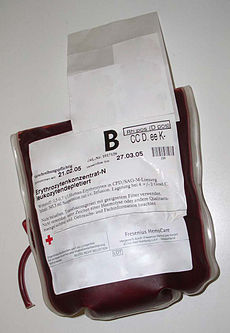การถ่ายเลือด
| การถ่ายเลือด | |
|---|---|
| การแทรกแซง | |
 ถุงพลาสติกขนาด 0.5–0.7 ลิตรที่มีเม็ดเลือดแดงแน่นในสารละลายซิเตรด ฟอสเฟต เดกซ์โตรสและอะดีนีน (CPDA) | |
| ICD-9-CM | 99.0 |
| MeSH | D001803 |
| OPS-301 code: | 8-80 |
| MedlinePlus | 000431 |
การถ่ายเลือดโดยทั่วไปเป็นกระบวนการรับผลิตภัณฑ์ของเลือดเข้าระบบไหลเวียนของบุคคลเข้าหลอดเลือดดำ การถ่ายเลือดใช้ในภาวะการแพทย์ต่าง ๆ เพื่อทดแทนส่วนประกอบของเลือดที่เสียไป การถ่ายเลือดช่วงแรก ๆ ใช้เลือดเต็ม แต่เวชปฏิบัติสมัยใหม่ทั่วไปใช้เฉพาะบางองค์ประกอบของเลือดเท่านั้น เช่น เม็ดเลือดแดง เม็ดเลือดขาว น้ำเลือด ปัจจัยจับลิ่มของเลือด (clotting factor) และเกล็ดเลือด
การใช้ทางการแพทย์
[แก้]ในอดีต การถ่ายเม็ดเลือดแดงพิจารณาเมื่อระดับฮีโมโกลบินต่ำกว่า 10 กรัมต่อเดซิลิตร หรือปริมาตรเม็ดเลือดแดงในเลือด (ฮีมาโทคริต) ต่ำกว่า 30% ("กฎ 10/30")[1][2] แต่เนื่องจากเลือดแต่ละหน่วยที่ให้มีความเสี่ยง ปัจจุบันปกติจึงใช้ระดับต่ำกว่า 7–8 กรัมต่อเดซิลิตรเพราะแสดงแล้วว่ามีผลลัพธ์ผู้ป่วยดีกว่า[3] การให้เลือดหนึ่งยูนิตเป็นมาตรฐานสำหรับบุคคลที่รับเข้ารักษาในโรงพยาบาลที่ไม่ตกเลือด โดยการรักษานี้ตามด้วยการประเมินซ้ำและการพิจารณาอาการและความเข้มข้นของฮีโมโกลบิน[3] ผู้ป่วยที่มีความอิ่มตัวของออกซิเจนต่ำอาจต้องการเลือดเพิ่ม[3] มีคำเตือนแนะนำให้ใช้การถ่ยเลือดเฉพาะภาวะเลือดจางที่่อนข้างรุนแรงเท่านั้น ส่วนหนึ่งจากหลักฐานว่าผลลัพธ์เลวลงหากให้เลือดปริมาณมากขึ้น[4] แพทย์อาจพิจารณาถ่ายเลือดแก่บุคคลที่มีอาการของโรคหัวใจหลอดเลือด เช่น เจ็บอกหรือหายใจสั้น[2] ในกรณีที่ผู้ป่วยมีฮีโมโกลบินระดับต่ำแต่ระบบหัวใจหลอดเลือดเสถียร เหล็กโดยฉีด (parenteral iron) เป็นทางเลือกที่แนะนำโดยอิงประสิทธิพลังและความปลอดภัย[5] ให้ผลิตภัณฑ์ของเลือดอื่นตามความเหมาะสม เช่น การขาดปัจจัยเลือดจับลิ่ม.
อ้างอิง
[แก้]- ↑ Adams RC, Lundy JS: Anesthesia in cases of poor surgical risk. Some suggestions for decreasing risk. Surg Gynecol Obstet 1942; 74:1011–1019.
- ↑ 2.0 2.1 Carson, JL; Grossman, BJ, Kleinman, S, Tinmouth, AT, Marques, MB, Fung, MK, Holcomb, JB, Illoh, O, Kaplan, LJ, Katz, LM, Rao, SV, Roback, JD, Shander, A, Tobian, AA, Weinstein, R, Swinton McLaughlin, LG, Djulbegovic, B, for the Clinical Transfusion Medicine Committee of the, AABB (Mar 26, 2012). "Red Blood Cell Transfusion: A Clinical Practice Guideline From the AABB". Annals of internal medicine. doi:10.1059/0003-4819-156-12-201206190-00429 (inactive 2015-01-10). PMID 22454395.
{{cite journal}}: CS1 maint: DOI inactive as of มกราคม 2015 (ลิงก์) CS1 maint: multiple names: authors list (ลิงก์) - ↑ 3.0 3.1 3.2 American Association of Blood Banks (24 April 2014), "Five Things Physicians and Patients Should Question", Choosing Wisely: an initiative of the ABIM Foundation, American Association of Blood Banks, สืบค้นเมื่อ 25 July 2014
- ↑ Villanueva, C; Colomo, A; Bosch, A; Concepción, M; Hernandez-Gea, V; Aracil, C; Graupera, I; Poca, M; Alvarez-Urturi, C; Gordillo, J; Guarner-Argente, C; Santaló, M; Muñiz, E; Guarner, C (2013). "Transfusion strategies for acute upper gastrointestinal bleeding". The New England Journal of Medicine. 368 (1): 11–21. doi:10.1056/NEJMoa1211801. PMID 23281973.
- ↑ Gasche, C; Berstad, A; Befrits, R; Beglinger, C; Dignass, A; Erichsen, K; Gomollon, F; Hjortswang, H; Koutroubakis, I; Kulnigg, S; Oldenburg, B; Rampton, D; Schroeder, O; Stein, J; Travis, S; Van Assche, G (2007). "Guidelines on the diagnosis and management of iron deficiency and anemia in inflammatory bowel diseases" (PDF). Inflammatory bowel diseases. 13 (12): 1545–53. doi:10.1002/ibd.20285. PMID 17985376.
แหล่งข้อมูลอื่น
[แก้]- Cochrane Injuries Group เก็บถาวร 2020-08-03 ที่ เวย์แบ็กแมชชีน, publishes systematic reviews of interventions for traumatic injury, which include evaluations of blood and blood substitute transfusions
- Cochrane Haematological Malignancies Group เก็บถาวร 2016-02-06 ที่ เวย์แบ็กแมชชีน, publishes systematic reviews of interventions for haematological disorders and evaluations of blood and blood substitute transfusions.
- Transfusion Evidence Library searchable source of evidence for transfusion medicine.
